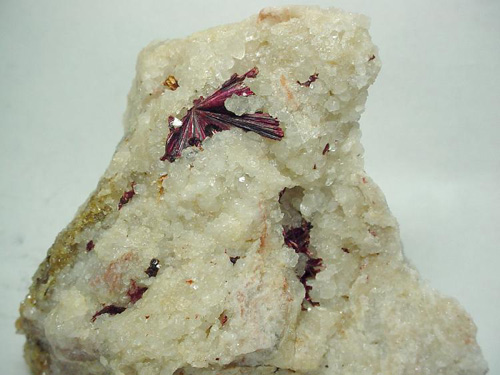The Mineral erythrite

Erythrite is a deeply colored reddish or pink mineral, with its distinctive color caused by its cobalt content. Erythrite is the end member of a series with Annabergite, with Erythrite being the cobalt-dominant member and Annabergite being the nickel-dominant member. Erythrite is named from the Greek erythros, red, in reference to the hue of this mineral.
Chemical Formula
Co3(AsO4)2 · 8(H2O)
Color
Deep purplish-red, hot pink, light pink, dark pinkish-red; sometimes with a bluish hue.
Crystal System
Monoclinic
Properties
Streak
Light red to pink |
Hardness
1.5 - 2.5 |
Transparency
Transparent to translucent |
Specific Gravity
3.0 - 3.2 |
Luster
Vitreous, pearly |
Cleavage
1,1 |
Fracture
Splintery |
Tenacity
Sectile and slightly flexible |
Uses
Erythrite is an ore of cobalt, and is an important collectors mineral.
Noteworthy Localities
The classic type locality of Erythrite is the Schneeberg District, Saxony, Germany, where this mineral was found in bright radiating and acicular sprays on matrix. Until modern times, Schneeberg was considered to be the finest occurrence of this mineral. Good specimens from this locality are hard to come across today as most of the outstanding examples are in old and classic collections.
The largest Erythrite crystals ever found come from the Bou Azer district in Morocco. This region has been producing outstanding, vividly-colored masterpieces with beautiful color and form. Specific notable deposits in Bou Azer include the Aghbar Mine and the Agoudal Mine.
Other notable Erythrite occurrences are Mt. Cobalt, Queensland, Australia; the Sara Alicia Mine, near Alamos, Sonora, Mexico (hot pink fibrous acicular groups); and Cobalt, Timiskaming District, Ontario, Canada (pink crusts, sometimes associated with Silver).
The U.S. lacks significant Erythrite occurrences. Two localities that have produced small crusts are the French Creek Mines, St. Peters, Chester County, Pennsylvania; and the the Blackbird District, Lemhi Co., Idaho.
Distingushing Similar Minerals
Due to the color and habits of Erythrite, it is is not easily confused with other minerals.